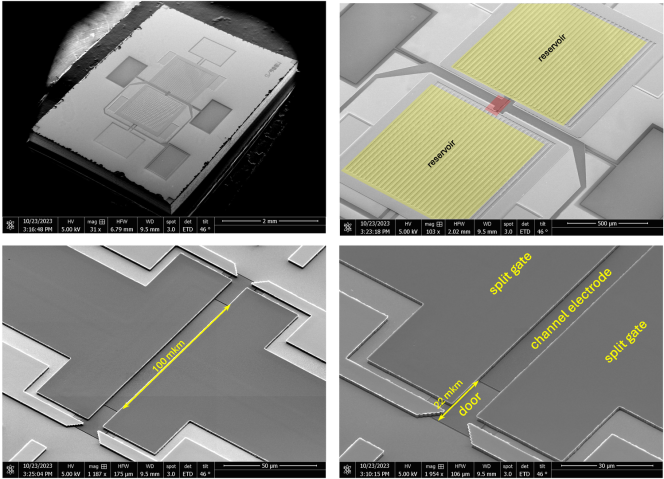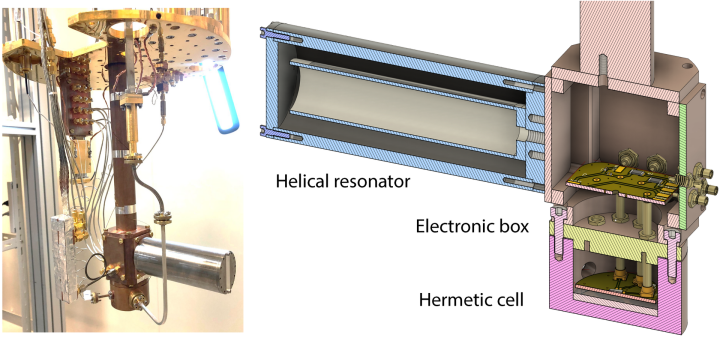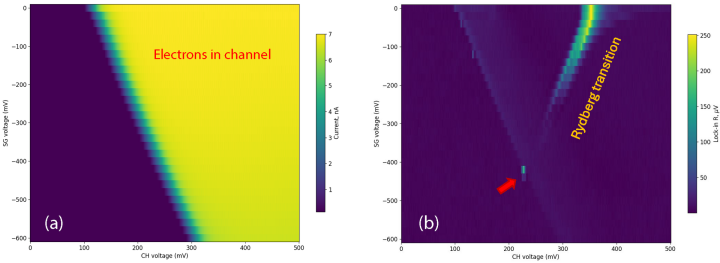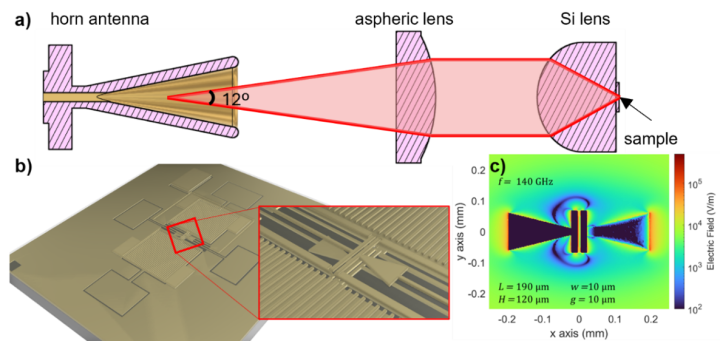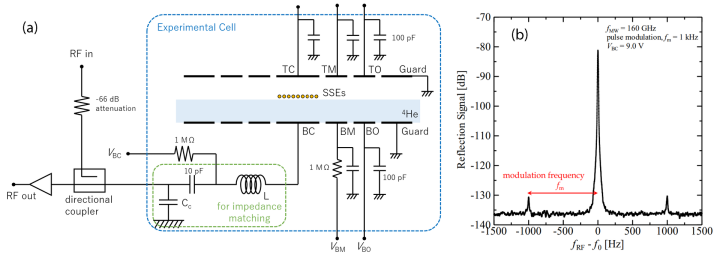Abstract
In FY2023, our group continued experimental effotrs towards realizing our theoretical proposal of hybrid Rydberg-spin qubits on the surface of superfluid helium. In particular, our efforts were concentrated on developing two methods for ultra-sensitive detection of the Rydberg transtion of electrons on liquid helium and scalability of this method towards detecting the transtion spectrum of a single electron. We also start investigating quasi-optical methods for microwave (~200 GHz) field enhancement, which would be important for fast manipulation of the Rydberg qubit. In addition, we have build a new experimental setup for trapping electrons on solid neon, with the goal of investigating the properies of such electrons and possibility to use their Rydberg states for building long-coherence qubits.
In FY2023, we said farwell to Dr. Kirill Shulga who moved to University of Tokyo and Dr. Ivan Kostylev who took position in the group of Yuimaru Kubo at the OIST Science&Technology Group, and we wellcomed a new member Dr. Natalia Morais, who joint our group as a new postdoc.
1. Staff
- Dr. Ivan Kostylev, Postdoctoral Scholar
- Dr. Kirill Shulga, Postdoctoral Scholar
- Dr. Mikhail Belianchikov, Postdoctoral Scholar
- Dr. Tomoyuki Tani, Postdoctoral Scholar
- Dr. Jui-Yin Lin, Postdoctoral Scholar
- Dr. Wanting He, Postdoctoral Scholar
- Natalia Morais, Postodoctoral Scholar
- Ka Wing Yip, Graduate student
- Taki Tazuke, Research Unit Administrator
2. Collaborations
2.1 Delocalized magntoplasmons in a two-dimensional electron fluid
- Description: We found a new delocalised magnetoplasmon mode in 2D electrons on liuqid helium and, with the help of our collaborator, confirmed it by numerical simulations.
- Type of collaboration: Joint research
- Researchers:
- Dr. Alexei Chepelianskii, University Paris-Sacley
2.2 RF reflectometry method for the Rydberg state detection of electrons on liquid helium
- Description: We developed a method of the Rydberg state detection based on RF reflection from a high-quality superconducting LC circuit
- Type of collaboration: Joint research
- Researchers:
- Dr. Erika Kawakami, Center for Quantum Computing, RIKEN
3. Activities and Findings
3.1 Microchannel device for electron trapping and manipulation (N. Morais and M. Belianchikov)
We developed a microchannel device for trapping and manipulating a small number of electrons on the surface of superfluid helium. The device if fabricated by standard optical lithography methods and consists of two microchannel arays forming "reservoirs" for elecron storage connected by a single channel (see Fig. 1). The bottom electrode structure of the central channel consists of a cenral "trap" electrode of virable length (100 mu in Fig. 1) and two "door" electrodes on the channel sides to separate electrons in the storage from the trap. Our electrostatic FEM calculations allow us to simulate the potential energy of electrons inside the trap and predict the electrode bias voltages for electron trapping (see Fig. 2).
Figure 1: Microchannel device for electron trapping and manipulation.
Figure 2: FEM simulation of the electrostatic potential in microchannel device.
3.2 Experimental setup for the Rydberg-transition image-charge detection (M. Belianchikov)
We have build a cryogenic RF setup for an ultra-sensitive detection of the Rydberg transtion in electrons on helium (see Fig. 3). At the heart of the image-charge detection is a high-quality (QLOAD~1300) superconducting (helical) resonator that allows to convert a smal current expected from the Rydberg transtion of a single electron (~5 fA) into a volatge signal that can be amplified by a cryogenic LNA and detect at the room temperature. With this setup, we measured current noise 1.5 fA per sq.root Hz, which should be sufficent to detect the signal from a single electron.
Figure 3: New experimental setup for the image-charge detection of the Rydberg resonace of electrons on helium.
3.3 Detection of the Rydberg transition of electrons trapped in the microchannel device (M. Belianchikov and N. Morais)
We carried out preliminary low temperature experiments to trap a small number of electrons in a central channel of our microchannel device and detect their Rydberg transition by the image-charge detection method. First, we performed standard dc tarnsport measurements of elecrons through the channel by the Sommer-Tanner method, see Fig. 4(a). The green region corresponds to the electrons filling the central channel. Then, we performed the image-charge detection measurements of the Rydberg transition, which can be Stark-tuned into resonance with applied microwave excitation by the applied DC voltages , see Fig. 4(b). We observe a strong signal due to the Rydberg transtion when electrons are filling the channel. Surprisingly, we observe a strongly enhanced transtion signal when elecrons are very close to the depletion threshold, see red arrow in Fig. 4(b). This corresponds to the transition spectrum of a few electrons. However, the origin of the strong enhancement is not understood yet.
Figure 4: (a) Sommer-Tanner measurements of electron transport through the central channel. The border between yellow and dark-blue regions indicates the depletion of channel of electrons. (b) The image-charge signal of microwave-excited electrons showing the Rydberg transtion of electrons in the channel and a strong resonant signal at the depletion threshold (indicated by red arrow).
3.4 Molecular dynamic simulations of a few trapped electrons (M. Belianchikov and J.-Y. Lin)
In order to understand the results of experiements with a small number of electrons in a microchannel, we have started to perform the molecular dynamic (MD) calculations to find the equalibrium position of electrons in the trapping potential and their Rydberg spectra. First, we perform FEM calculations to find the electrostatic trapping potential, see Fig. 5(a). Then, by properly parametrizing these results and finding an analytical approximation for the trapping potential, we perform MD simulations by randomly placing a fixed number N of electrons into the potenial and perform temperature annealing to find their equilibrium configuration, see Fig. 5(b). An example of equlibrium configuartion for N=100 elecrons is shown in Fig. 5(c). In the future, we plan to use this results to recover the Stark-shifted Rydberg spectra of a given number on electrons and compare it with the experimental resulst.
Figure 5: (a) FEM simulations of the trapping electrostatic potential. (b) MD simulations of N randomly placed electrons. (c) Equilibrium positions of N=100 electrons in the electrostatic trap.
3.5 Quasi-optical setup for microwave field enhancement (N. Morais and M. Belianchikov)
In the future quatum computer, it will be important to develop control over the microwave excitation field applied to the Rydberg-spin qubits, as well as enhance the field for fast qubit operation. For this purpose, we started developing a quasi-optical micorawave setup working at the frequency range 200-500 GHz. For the sake of field dirrectivity and enhancement, we use a horn antenna followed by a focussing lense, see Fig. 6(a). Using this simple setup, we demonstrated 75 dB (5,500 in electric field amplitude) field enhancement measuerd by a HEMT detector. In the future, we plan to use a baw-tie antenna incorporated with our microchannel device (see Fig. 6(b)) to control polarization of the applied microwave excitation, as well as to provide an additional estimated enhancement of the radiation field of 24 dB, see Fig. 6(c).
Figure 6: (a) Quasi-optical setup for microwave (~200 GHz) field enhancement consisting of horn antenna and focusing lenses. (b) Micorwave baw-tie antenna incorporated into the structure of the microchannel device. (c) FEM calculations of the microwave field around the bow-tie antenna showing its enhancement by 24 dB.
3.6 Detection of the Rydberg transtion of electrons on helium by RF reflectometry with pulse-mudulated microwave excitation (J.-Y. Lin and T. Tani)
We carried out low temperature experiments to detect the Rydberg transition of many electrons (N~108) on the bulk liquid helium using the RF reflectometry method discussed earlier (see FY2022 Annual Report). The principle circuit of the experiment is show in Fig. 7(a). The resonace signal is recorded as a sideband signal in the RF reflection spectrum at the frequencies f0+/-fm, where f0 is the resonant frequency of the LC circut and fm is the modulation frequency of the microwave excitation.
Figure 7: (a) Principle circuit of the RF reflectometry setup. The electron responce is detected by the RF signal at fRF~100 MHz refleced from a series LC ciruit coupled capacitively to the surface electrons (SSEs). (b) An example of RF reflection spectrum showing a sideband responce to the pulse-modulated microwave excitation at fm~1 kHz.
In order to enhance sensitivity of the detection method, we also employed the demodulation setup where the sideband signal is mixed with the RF driving signal and recorded at the modulation frequency fm~1 kHz using an ordinary lock-in amplifier (se Fig. 8(a)). An example of the recorded demodulated signal is shown in Fig. 8(b). Here, the electrons are Stark-tuned to the Rydberg resonance by the DC voltage VBC applied to the gate electrode below SSEs.
Figure 8: (a) Principle circuit of the RF demodulation setup . (b) An example of demodulated responce to the Rydberg transition in electrons Stark-tuned to resonance with the applied microwave radiation.
3.7 Prelininary exepriments on solidification of solid neon for electrons-on-neon experiments (T. Tani and K. W. Yip)
We started pleliminary experiments using an experiemental cell attached to 10 K stage of a Griffon-MacMahon cooler (see Fig. 9(a)) to prepare a clean surface of solid neon which can be used to trap surface elecrons. The Rydberg states of such electrons, which correspond to the ferquency range ~2 THz, could be a promising system to realize high-coherence charge qubits. In our experiment, we could sucessfully solidify solid neon by cooling the condensed neon gas below the triple point Tc~24.6 K and detect the position of neon solid-vapor interface by measuring capacitance between two plates enclosing the solidified neon (see Fig. 9(b)). Our next goal is to charge the surface of solid neon with electrons and investigate theit properties using the transport measurements.
Figure 9: (Left) Photograph of the experiemental cell attached to 10 K stage of a GM cooler for solidification of neon. (Right) Time recordings of capacitance, temperature and pressure of neon vapor in the experimental cell showing solidification of neon (plateau in temperature) at the tripple point Tc~24.6 K.
4. Publications
4.1 Journals
- Kawakami, E., Chen, J., Benito, M., Konstantinov, D., Blueprint for quantum computer using electrons on helium, https://doi.org/10.1103/PhysRevApplied.20.054022 (2023).
- Belianchikov, M., Kraus, J. A., Konstantinov, D., Cryogenic resoance amplifier for elecytron-on-helium image charge detection, https://doi.org/10.1107/s10909-023-03033-6 (2024).
4.2 Books and other one-time publications
Nothing to report
4.3 Oral and Poster Presentations
- Konstantinov, D., Rydberg state detection for electron on helium qubit, invited talk at the International Symposium on Quantum Fluids and Solids, Manchester, 12 August (2023).
- Lin, J.-Y., Fast charge sensing for quantum state detection in electrons on helium, poster presentaion at International Symposium on Quantum Fluids and Solids, Manchester, 12 August (2023).
- Belianchikov, M., Resoant image chrage detection for e-@He qubits, poster presentaion at International Symposium on Quantum Fluids and Solids, Manchester, 12 August (2023).
- Tani, T., Rydberg transition of surface state electrons on liquid-4 sensed by RF reflectometry, poster presentaion at Symposium on Quantum Fluids and Solids, Manchester, 12 August (2023).
- Tani, T., 高周波反射率測定による液体ヘリウム上電子のリュードベリ遷移の検出, oral talk (on-line) at the Spring JPS Meeting, Marhc 21 (2024).
- Belianchikov, M., Resoant image chrage detection for e-@He qubits, poster presentation at International Conference Quantum Innovation (QI 2023), Tokyo, 16 November, 2023.
- Morais, N., Towards quasioptical micorwave field enhancement for electrosn on helium qubits, poster presentation at International Conference Quantum Innovation (QI 2023), Tokyo, 16 November, 2023.
5. Intellectual Property Rights and Other Specific Achievements
Nothing to report
6. Grants
Grant-in-Aids for Scientific Research KAKENHI MEXT, Grant Number 23H01795: "Realization of high-fidelity quantum logic gates using electron spins on superfluid helium" (FY2023)





